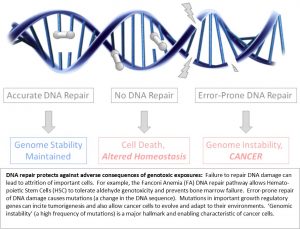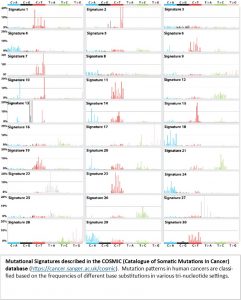Environmental Exposures, Genomic Instability and Cancer
Genome Maintenance:
Accurate replication and repair of DNA is essential for all life. The ways in which DNA damage is sensed, processed and repaired (collectively termed ‘genome maintenance’) critically determine whether cells survive and preserve their genomes following DNA-damaging exposures.
Environmental Genotoxins:
Many ubiquitous environmental agents are genotoxic (i.e. cause DNA damage). It is estimated that each human cell is subject to approximately 70,000 DNA lesions per day from intrinsic sources alone. Environmental exposures can add to the burden of DNA damage experienced by human cells. Multiple genome maintenance mechanisms have evolved to sense and repair the diverse species of DNA damage.

How DNA repair capacity and fidelity impact human health:
Unrepaired DNA damage can kill cells, disrupt developmental processes and lead to altered homeostasis and disease including cancer. Moreover, many common genotoxic exposures cause mutations that incite cancer. For example, sunlight induces skin cancer, aflatoxin B1 leads to liver cancer, and tobacco smoke causes lung cancer.

Mutations and Cancer:
Cancer genome sequencing efforts have revealed 30 discrete mutational patterns termed ‘mutational signatures’. Interestingly, for most of the 30 mutational signatures annotated in the COSMIC database, the underlying mutagenic mechanism is unknown. There remain major gaps in our knowledge of how genotoxic exposures and error-prone DNA repair pathways generate the different mutational signatures.

Why Study Genome maintenance?
Congenital defects in DNA repair genes (e.g. NER, FA) often predispose to cancer and other diseases. It is important to define the environment-gene interactions that impact genome maintenance if we are to better predict, prevent and treat environmentally-induced disease.
The genome maintenance mechanisms that protect normal cells against environmental exposures also allow cancer cells to resist genotoxic therapies. Therefore, DNA repair pathways are molecular vulnerabilities that could be targeted to sensitize tumors to therapy.
The mutational signatures in tumors are records of past DNA-damaging exposures and genome maintenance events. Deciphering the DNA repair processes responsible for mutational signatures will allow precision medicine and selection of chemotherapy based on the unique genome maintenance processes in each individual cancer.
DNA Repair, Cancer and related research areas at UNC:
DNA repair and genome maintenance are particular strengths and focus areas for UNC researchers. One of our faculty members, Dr. Aziz Sancar received the 2015 Nobel Prize in Chemistry for his seminal work on DNA repair mechanisms that protect against the harmful effects of solar radiation (https://www.nobelprize.org/prizes/chemistry/2015/sancar/facts/).

UNC researchers are using diverse approaches including biochemistry, cell biology, mouse models, genetics and computational biology to understand mechanisms of genome maintenance and consequences of DNA repair pathway choice on genomic stability, development and susceptibility to disease (including cancer). See list of faculty and research interests below.
Many CiT-affiliated researchers in the Genome Integrity & Structural Biology Lab at The National Institute for Environmental Health Sciences (NIEHS) are also world leaders in DNA repair (https://www.niehs.nih.gov/research/atniehs/labs/gisbl/pi/index.cfm)
Many CiT faculty also belong to the Lineberger Comprehensive Cancer Center (LCCC, https://unclineberger.org/). LCCC-affiliated DNA repair researchers seek to understand how genome maintenance contributes to tumorigenesis and to harness our understanding of genome maintenance pathways to devise improved cancer therapies.
CiT-affiliated DNA Repair and Genome Maintenance Researchers:
 |
Jean Cook | DNA replication and Repair |
 |
Jack Griffith | electron microscopy, visualization of protein/DNA interaction |
 |
Gaorav Gupta | Mechanisms of mutagenesis and therapy-resistance in breast cancer |
 |
Katie Hoadley | gene expression analyses and integrative genomic approaches to cancer biology |
 |
Billy Kim | renal cancer, role of APOBEC in mutational signatures |
 |
Joel Parker | computational approaches to studying genomic instability and mutational signatures |
 |
Dale Ramsden | Mechanisms of DNA Double Strand Break repair |
 |
Aziz Sancar | Nucleotide Excision Repair, checkpoint signaling, circadian clock |
 |
Melissa Troester | environment, mutational patterns and breast cancer |
 |
Cyrus Vaziri | Trans-Lesion Synthesis, DNA damage tolerance and mutagenesis, Cancer-Specific genome maintenance pathways |